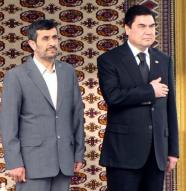|
|
|
President Mahmoud Ahmadinejad (L) and his Turkmen counterpart Gurbanguly Berdymukhamedov. Photo by AFP. |
During a recent visit to Iranian expatriates in Turkmenistan, President Mahmoud Ahmadinejad made several announcements about the Islamic Republic’s energy alliances with Central Asia. One development in particular stood out.
In a joint press conference, Ahmadinejad and Turkmen president Gurbanguly Berdimuhamedow announced construction of a second natural gas pipeline, which is due to transfer natural gas from Turkmenistan to Iran. The current pipeline sends 8 billion cubic meters of natural gas to Iran, and Turkmenistan has agreed to increase the volume to 14 billion cubic meters when construction on the new pipeline begins this year. With both pipelines in place, the regional energy trade between Turkmenistan and Iran could reach 20 billion cubic meters annually. The new pipeline is scheduled to pass through the cities of Dauletabad, Sarakhs, and Khangiran.
While it has only limited supplies of refined petroleum, Iran sits on top of the world’s second largest reserve of natural gas. According to the Oil and Gas Journal, Iran has natural gas reserves on the order of 948 trillion cubic feet (approx. 28 trillion cubic meters), second only to Russia. Approximately half of the nation’s gas sits under the water of the Persian Gulf in the South Pars field near the emirate of Qatar. Development of this field is heavily subsidized by the Iranian government through an entity called the Pars Oil & Gas Company (a subsidiary of the National Iranian Oil Company).
Despite the vast reserves of natural gas, two thirds of Iran’s energy sector is underdeveloped. Due to the country’s enormous growth since the Islamic Revolution in 1979, energy shortages are common in many areas. In fact, some regions of the Islamic Republic still are compelled to import energy supplies from neighboring countries. As a chief energy producer in Central Asia, Turkmenistan has been able to meet this need. Iranian Deputy Petroleum Minister Reza Kassanzade is also conducting talks with the government in Baku about importing natural gas from Azerbaijan’s Shah Deniz field. The Iranians are exploring this new alliance with Azerbaijan because of continued difficulties with Turkmenistan over the pricing mechanism of its gas trade.
A prima facie investigation of Iran’s energy situation would point to the country’s vast shortages as the main reason for these new alliances. The reality, however, is far more complex, and more troubling. Iran is exploring these new energy alliances because it positioning itself to be the chief energy broker in the Middle East. After Saudi Arabia, Iran has the region’s second largest reserve of petroleum. If the Islamic Republic were able to secure a majority stake in both petroleum and natural gas, the world would have to treat it as a major power broker.
Iran’s unique geography serves this purpose. With a northern border shared with Turkey and a shoreline on the Persian Gulf, Tehran has a foot in two of the world’s largest energy markets: Europe and Asia. With energy consumption in Europe increasing, and energy production by the UK, Denmark, Norway, and Italy decreasing, the EU will continue to rely on access to energy via pipelines in Turkey and the Persian Gulf. Energy consumption trends in Asia tell the same story. Booming industrial economies like China, Japan, and India, as well as smaller, high-tech economies like South Korea will have to return to the Persian Gulf-and Iran’s close ally Russia-to meet their energy needs in the decades ahead. Iranian meddling in Iraqi Kurdistan (with the oil-rich city of Kirkuk), and the southern Shia provinces (i.e., Basra) will further secure Persian dominance of the world energy trade.
While the rest of the world-including the United States-loses sleep over Tehran’s rapidly advancing nuclear program, the real problem lies deep in the pipelines of Central Asia and the Persian Gulf.
Are you a dedicated reader of FDD's Long War Journal? Has our research benefitted you or your team over the years? Support our independent reporting and analysis today by considering a one-time or monthly donation. Thanks for reading! You can make a tax-deductible donation here.









1 Comment
Iraq has far more oil reserves than Iran. Based on current negotiations with the western majors it is reasonable to project Iraq is the world’s largest oil exporter in fifteen years.
Unlike KSA, Iraq can use water-flooding to increase recoveries at a practical cost. To this date, KSA has hardly used water injection. Salt water is problematic as it is hard on all the equipment and normally fouls up the bearing strata at the point of injection.
Iranian gas is still being flared in the field so as to permit oil production. On the economics, their investment in nuclear power does not make sense.
The mullahs are setting themselves up to run a protection racket upon the neighborhood.
Turkmenistan has cut some monster deals with China which make Iran’s deposits forever second in line. Iraqi-Chinese contracts recently signed place her fields at the front of the pack. Consequently Chinese enthusiasm for Iranian oil development has fallen fast.